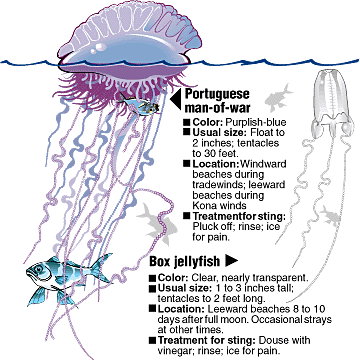7.24.2003
Rob's
Marine Momment
Jellyfish
is a funny name isn't it. Why do you think they call those
painfull stinging creatures of the sea jellyfish? They arn't
fish, thats for sure. They lack any sort of skeleton like
a fish and they don't have eyes, or any sort of real brain.
Their actions are completely controlled by what I like to
call 'programed' responses. So today I would like to talk
about 1) what are Jellyfish 2) What
is the actual stinging process and
3) how do you prevent from getting
stung and 4) if stung how to cure
yourself.
What
are Jellyfish
When
you think of the word jellyfish, what comes to mind? ...
remember, not a fish. My guess is, some sort of floaty-stinging
thing in the water. Hmmm. Ok thats a start. Shall we get
technical now? Lets through in some scientific jargon here
to define our 'jellyfish'.
The
kingdom Animalia is made up of many groups of organisms
(grouped by the way on common features). The first classification
(grouping) is Phyla. One of these if the Chordates (us -
ones with nerve chords), one is the Phylum Cnidaria (our
jellyfish). Cnidarians are made up of radially symetrical
organisms (like a pizza you can cut them up many ways and
get symetery - you can't do that with us). These include
corals, box jellyfish, portugesse man of war and sea anemones
(like Nemo's home). Got the picture.
Now,
this group is further divided into Classes. To put this
into perspective, birds are a class, reptiles a class and
mammals are a class. Our Cnidarians are also divided this
way. There are 4 main classes. They are:
- Class Schphozoa (The jellyfish, or jellies)
- Class Hydrozoa (Diverse polyps, including hydras - portugese
man-o-war)
- Class Cubozoa (A minor tropical class with cuboidal
swimming cups - Box jellies)
- Class Anthozoa (Sea anemones, corals)
Now I looked up the term 'jellyfish' in Encyclopedia
Brittanica and this is wat it said.
- any planktonic marine member
of the class Scyphozoa (phylum Cnidaria),
a group of invertebrate animals composed of about 200
described species, or of the class Cubozoa,
which was formerly considered an order of Scyphozoa. The
term is also frequently applied to certain other cnidarians
that have a medusoid (bell- or saucer-shaped) body form,
…
SO, what we call Box Jellyfish (Cubozoans)
are jellyfish -(south shore warnings). However, our windward
side jellyfish (Portugese man-o-war and Hydroids) are not
jellyfish at all - they are hydroids. Just about as closesly
related to a coral as to a real jellyfish. Thats like the
relationship between you and ... well, like my gecko friend
here that sits on my window seal.
What
is the stinging process?
Stinging is caused by the discharge of nematocysts.
Think of the nematocyst as a big coiled harpoon within a
jellyfish cell. Upon contact with an organism (of a different
species) it discharges. These harpoons are full of all sorts
of hooks and spines that not only creat a painfull sting,
they also allow the more painfull toxins to penetrate the
skin 
These toxins of course are vary diverse within
the Cnidarians. Corals have them, box jellies have them
and so do hydroids (portugese mano-o-war).
Now imagine you have no brain, you have no
teeth or a jaw and your skin was so soft that anything you
tried to capture could probably break you. Thats the jellyfish's
situation. Not to good huh? What it has are these stinging
cells. Now, toxin is costly to produce so you only want
to produce as potent of stuff as you might need. If you
specialize on eating fish, you better kill those suckers
before they kill you! So, our box jellies and man-o-wars,
which eat fish, have pretty potent stuff. The most potent
of all is the box jellyfish of Australia Chrionex fleckeri,
which can kill a man in 3 minutes.
Avoiding
Jelly fish stings!
The best way to avoid the stings of a jellyfish
is to wear some sort of protective clothing. This acts to
protect your skin from those painfull nematocysts. Thats
why we all wear those rash guards. The other way is to simply
know when the jellies might be out.

Man-o-wars are blown in so they are on the
windward sides when trades are blowing. Box jellies are
found on the leeward shores from 8 to 10 days after the
full moon (let me know if you want me to explain why). So,
if you don't want to be stung, either 1) don't swim during
these times or 2) if Dave makes you swim (well he never
makes us swim, we just feel pressured ... especially as
coaches), then swim behind someone - kinda like a downfeild
blocker! - j/k
How to
cure your wounds!
If you've been stung, you are not alone. Apparently
in Hawaii it ranks second in number of stings reported to
Hawaiian Poison Control. Then again, maybe not so many people
report it because centipeed stings rank number one. Maybe
I'm odd but I don't know anyone thats ever been stung by
a centipeed.
So how to cure the sting - remember those
toxins we talked about hat were released. That is what you
want to neutralize. Vinigear and meat tenderizer (but I
wouldn't used meat tenderizer as some reports say its bad)
are good for this (some say pee on it - hear thats better
than nothing). However, for box jelly stings use hot water
(some reports say thats not good either). A study
done by some researchers (couldn't find proper source) showed
that adding hot water would denature the toxins. They used
water at 104 degrees F. Whats good about hot water is that
it penetrates deep into the skin (obviously), and thus 'cures'
the toxin. Sweet!
But the odd thing is that many reports are
conflicting. Some say one thing is bad, some say its good.
You'll have to look at some of the links and decide.
Ok, I couldn't sleep earlier because I ate
box of brownies. Now, its 5:30am, when I'd normally be waking
up. I think I will go to bed.
Happy Swimming,
Scubarob
|